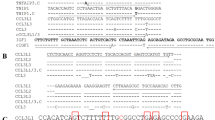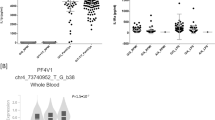Abstract
Caspases are important in the life and death of immune cells and therefore influence immune surveillance of malignancies. We tested whether genetic variants in CASP8, CASP10 and CFLAR, three genes important for death receptor–induced cell killing residing in tandem order on chromosome 2q33, are associated with cancer susceptibility. Using a haplotype-tagging SNP approach, we identified a six-nucleotide deletion (−652 6N del) variant in the CASP8 promoter associated with decreased risk of lung cancer. The deletion destroys a stimulatory protein 1 binding site and decreases CASP8 transcription. Biochemical analyses showed that T lymphocytes with the deletion variant had lower caspase-8 activity and activation-induced cell death upon stimulation with cancer cell antigens. Case-control analyses of 4,995 individuals with cancer and 4,972 controls in a Chinese population showed that this genetic variant is associated with reduced susceptibility to multiple cancers, including lung, esophageal, gastric, colorectal, cervical and breast cancers, acting in an allele dose–dependent manner. These results support the hypothesis that genetic variants influencing immune status modify cancer susceptibility.
This is a preview of subscription content, access via your institution
Access options
Subscribe to this journal
Receive 12 print issues and online access
$209.00 per year
only $17.42 per issue
Buy this article
- Purchase on Springer Link
- Instant access to full article PDF
Prices may be subject to local taxes which are calculated during checkout




Similar content being viewed by others
References
de Visser, K.E., Eichten, A. & Coussens, L.M. Paradoxical roles of the immune system during cancer development. Nat. Rev. Cancer 6, 24–37 (2006).
Green, D.R., Droin, N. & Pinkoski, M. Activation-induced cell death in T cells. Immunol. Rev. 193, 70–81 (2003).
Chappell, D.B. & Restifo, N.P. T cell-tumor cell: a fatal interaction? Cancer Immunol. Immunother. 47, 65–71 (1998).
Maher, S., Toomey, D., Condron, C. & Bouchier-Hayes, D. Activation-induced cell death: the controversial role of FAS and FAS ligand in immune privilege and tumor counterattack. Immunol. Cell Biol. 80, 131–137 (2002).
Yu, P. & Fu, Y.X. Tumor-infiltrating T lymphocytes: friends or foes? Lab. Invest. 86, 231–245 (2006).
Aggarwal, B.B. Signalling pathways of the TNF superfamily: a double-edged sword. Nat. Rev. Immunol. 3, 745–756 (2003).
Siegel, R.M. Caspases at the crossroads of immune-cell life and death. Nat. Rev. Immunol. 6, 308–317 (2006).
Ho, P.K. & Hawkins, C.J. Mammalian initiator apoptotic caspases. FEBS J. 272, 5436–5453 (2005).
Thorburn, A. Death receptor-induced cell killing. Cell. Signal. 16, 139–144 (2004).
Sun, T. et al. Polymorphisms of death pathway genes FAS and FASL in esophageal squamous-cell carcinoma. J. Natl. Cancer Inst. 96, 1030–1036 (2004).
Sun, T. et al. FASL-844C polymorphism is associated with increased activation-induced T cell death and risk of cervical cancer. J. Exp. Med. 202, 967–974 (2005).
Zhang, X. et al. Functional polymorphisms in cell death pathway genes FAS and FASL contribute to risk of lung cancer. J. Med. Genet. 42, 479–484 (2005).
Krippl, P., Langsenlehner, U., Renner, W., Koppel, H. & Samonigg, H. Re: Polymorphisms of death pathway genes FAS and FASL in esophageal squamous-cell carcinoma. J. Natl. Cancer Inst. 96, 1478–1479 (2004).
Sibley, K. et al. Functional FAS promoter polymorphisms are associated with increased risk of acute myeloid leukemia. Cancer Res. 63, 4327–4330 (2003).
MacPherson, G. et al. Association of a common variant of the CASP8 gene with reduced risk of breast cancer. J. Natl. Cancer Inst. 96, 1866–1869 (2004).
Frank, B. et al. Re: Association of a common variant of the CASP8 gene with reduced risk of breast cancer. J. Natl. Cancer Inst. 97, 1012 (2005).
Frank, B. et al. Association of the CASP10 V410I variant with reduced familial breast cancer risk and interaction with the CASP8 D302H variant. Carcinogenesis 27, 606–609 (2006).
Cox, A. et al. A common coding variant in CASP8 is associated with breast cancer risk. Nat. Genet. 39, 352–358 (2007).
Couzin, J. Genomics. The HapMap gold rush: researchers mine a rich deposit. Science 312, 1131 (2006).
Bond, G.L. et al. A single nucleotide polymorphism in the MDM2 promoter attenuates the p53 tumor suppressor pathway and accelerates tumor formation in humans. Cell 119, 591–602 (2004).
Medema, J.P. et al. FLICE is activated by association with the CD95 death-inducing signaling complex (Drosoph. Inf. Serv.C). EMBO J. 16, 2794–2804 (1997).
Boldin, M.P., Goncharov, T.M., Goltsev, Y.V. & Wallach, D. Involvement of MACH, a novel MORT1/FADD-interacting protease, in Fas/APO-1- and TNF receptor-induced cell death. Cell 85, 803–815 (1996).
Muzio, M. et al. FLICE, a novel FADD-homologous ICE/CED-3-like protease, is recruited to the CD95 (Fas/APO-1) death–inducing signaling complex. Cell 85, 817–827 (1996).
Teitz, T. et al. Caspase 8 is deleted or silenced preferentially in childhood neuroblastomas with amplification of MYCN. Nat. Med. 6, 529–535 (2000).
Soung, Y.H. et al. CASPASE-8 gene is inactivated by somatic mutations in gastric carcinomas. Cancer Res. 65, 815–821 (2005).
Soung, Y.H. et al. Caspase-8 gene is frequently inactivated by the frameshift somatic mutation 1225_1226delTG in hepatocellular carcinomas. Oncogene 24, 141–147 (2005).
Kim, H.S. et al. Inactivating mutations of caspase-8 gene in colorectal carcinomas. Gastroenterology 125, 708–715 (2003).
Liedtke, C., Groger, N., Manns, M.P. & Trautwein, C. The human caspase-8 promoter sustains basal activity through SP1 and ETS-like transcription factors and can be up-regulated by a p53-dependent mechanism. J. Biol. Chem. 278, 27593–27604 (2003).
Scaffidi, C., Medema, J.P., Krammer, P.H. & Peter, M.E. FLICE is predominantly expressed as two functionally active isoforms, caspase-8/a and caspase-8/b. J. Biol. Chem. 272, 26953–26958 (1997).
Breckenridge, D.G., Nguyen, M., Kuppig, S., Reth, M. & Shore, G.C. The procaspase-8 isoform, procaspase-8L, recruited to the BAP31 complex at the endoplasmic reticulum. Proc. Natl. Acad. Sci. USA 99, 4331–4336 (2002).
Himeji, D. et al. Characterization of caspase-8L: a novel isoform of caspase-8 that behaves as an inhibitor of the caspase cascade. Blood 99, 4070–4078 (2002).
Ju, S.T. et al. FAS (CD95)/FASL interactions required for programmed cell death after T-cell activation. Nature 373, 444–448 (1995).
Evan, G.I. & Vousden, K.H. Proliferation, cell cycle and apoptosis in cancer. Nature 411, 342–348 (2001).
Lowe, S.W. & Lin, A.W. Apoptosis in cancer. Carcinogenesis 21, 485–495 (2000).
Lee, S.H. et al. Alteration of Fas (APO-1/CD95) gene in non-small cell lung cancer. Oncogene 18, 3754–3760 (1999).
Gratas, C. et al. Up-regulation of Fas (APO-1/CD95) ligand and down-regulation of Fas expression in human esophageal cancer. Cancer Res. 58, 2057–2062 (1998).
Reesink-Peters, N. et al. Death receptors and ligands in cervical carcinogenesis: an immunohistochemical study. Gynecol. Oncol. 96, 705–713 (2005).
Gutierrez, L.S., Eliza, M., Niven-Fairchild, T., Naftolin, F. & Mor, G. The Fas/Fas-ligand system: a mechanism for immune evasion in human breast carcinomas. Breast Cancer Res. Treat. 54, 245–253 (1999).
Shin, M.S. et al. Mutation of tumor necrosis factor-related apoptosis-inducing ligand receptor 1(TRAIL-R1) and receptor 2 (TRAIL-R2) genes in metastatic breast cancers. Cancer Res. 61, 4942–4946 (2001).
Park, W.S. et al. Inactivating mutations of KILLER/DR5 gene in gastric cancers. Gastroenterology 121, 1219–1225 (2001).
Kase, C. et al. Expression of Fas and Fas ligand in esophageal tissue mucosa and carcinomas. Int. J. Oncol. 20, 291–297 (2002).
Zhang, X. et al. Identification of functional genetic variants in cyclooxygenase-2 and their association with risk of esophageal cancer. Gastroenterology 129, 565–576 (2005).
Liu, F. et al. Genetic variants in cyclooxygenase-2: expression and risk of gastric cancer and its precursors in a Chinese population. Gastroenterology 130, 1975–1984 (2006).
Sun, T. et al. Functional Phe31Ile polymorphism in Aurora A and risk of breast carcinoma. Carcinogenesis 25, 2225–2230 (2004).
Tan, W. et al. Association of functional polymorphisms in cyclooxygenase-2 and platelet 12-lipoxygenase with risk of occurrence and advanced disease status of colorectal cancer. Carcinogenesis published online 6 December 2006 (doi:10.1093/carcin/bgl242).
Carlson, C.S., Eberle, M.A., Kruglyak, L. & Nickerson, D.A. Mapping complex disease loci in whole-genome association studies. Nature 429, 446–452 (2004).
Buetow, K.H. et al. High-throughput development and characterization of a genomewide collection of gene-based single nucleotide polymorphism markers by chip-based matrix-assisted laser desorption/ionization time-of-flight mass spectrometry. Proc. Natl. Acad. Sci. USA 98, 581–584 (2001).
Acknowledgements
This work was supported by National Natural Science Foundation grant 30530710 and State Key Basic Research Program grant 2004CB518701 (D.L.) and by grant 2002AA232031 from the Mega-Projects of Science Research for the 10th Five-Year Plan and the Hundred Talents Program of the Chinese Academy of Sciences (C.Z.).
Author information
Authors and Affiliations
Contributions
T.S. performed most of the experiments and the data analyses and wrote the manuscript; Y. Gao, S.M. and Q.Z. contributed to SNP discovery and Sequenom genotyping; Z.C. supervised SNP discovery and Sequenom genotyping; W.T., Y. Guo, M.Y. and X.Z. managed DNA samples and clinical information; Y.S. and J.Y. performed flow cytometry analyses and D.L. performed the data analyses, prepared the manuscript and supervised this study.
Corresponding authors
Ethics declarations
Competing interests
The authors declare no competing financial interests.
Supplementary information
Supplementary Fig. 1
LD block of the CFLAR-CASP8-CASP10 region. (PDF 65 kb)
Supplementary Table 1
Characteristics of individuals with lung cancer and control subjects. (PDF 34 kb)
Supplementary Table 2
Association between tag SNPs and lung cancer risk. (PDF 25 kb)
Supplementary Table 3
Activation of T lymphocytes in PBMCs. (PDF 15 kb)
Supplementary Table 4
Distribution of characteristics of affected individuals and controls. (PDF 19 kb)
Supplementary Table 5
Primer sequences. (PDF 65 kb)
Rights and permissions
About this article
Cite this article
Sun, T., Gao, Y., Tan, W. et al. A six-nucleotide insertion-deletion polymorphism in the CASP8 promoter is associated with susceptibility to multiple cancers. Nat Genet 39, 605–613 (2007). https://doi.org/10.1038/ng2030
Received:
Accepted:
Published:
Issue Date:
DOI: https://doi.org/10.1038/ng2030
This article is cited by
-
Association of apoptosis-related variants to malaria infection and parasite density in individuals from the Brazilian Amazon
Malaria Journal (2023)
-
Genetic contribution of caspase-8 variants and haplotypes to breast cancer risk and prognosis: a case-control study in Iran
BMC Medical Genomics (2023)
-
The relation between SNPs in the NME1 gene and response to sofosbuvir in Egyptian patients with chronic HCV
Beni-Suef University Journal of Basic and Applied Sciences (2023)
-
Prevalence of cancer susceptibility variants in patients with multiple Lynch syndrome related cancers
Scientific Reports (2021)
-
Comprehensive functional annotation of susceptibility variants identifies genetic heterogeneity between lung adenocarcinoma and squamous cell carcinoma
Frontiers of Medicine (2021)



